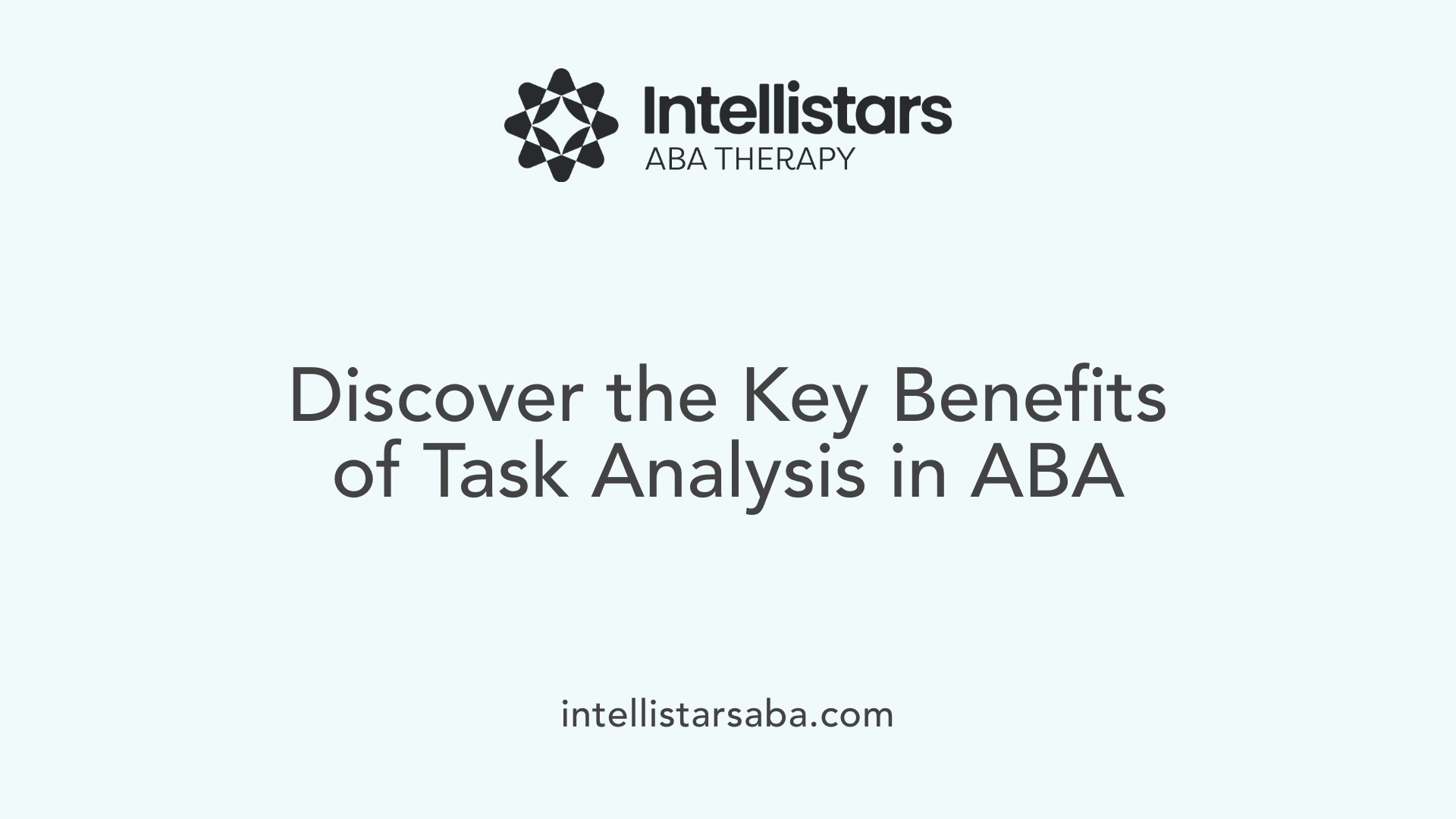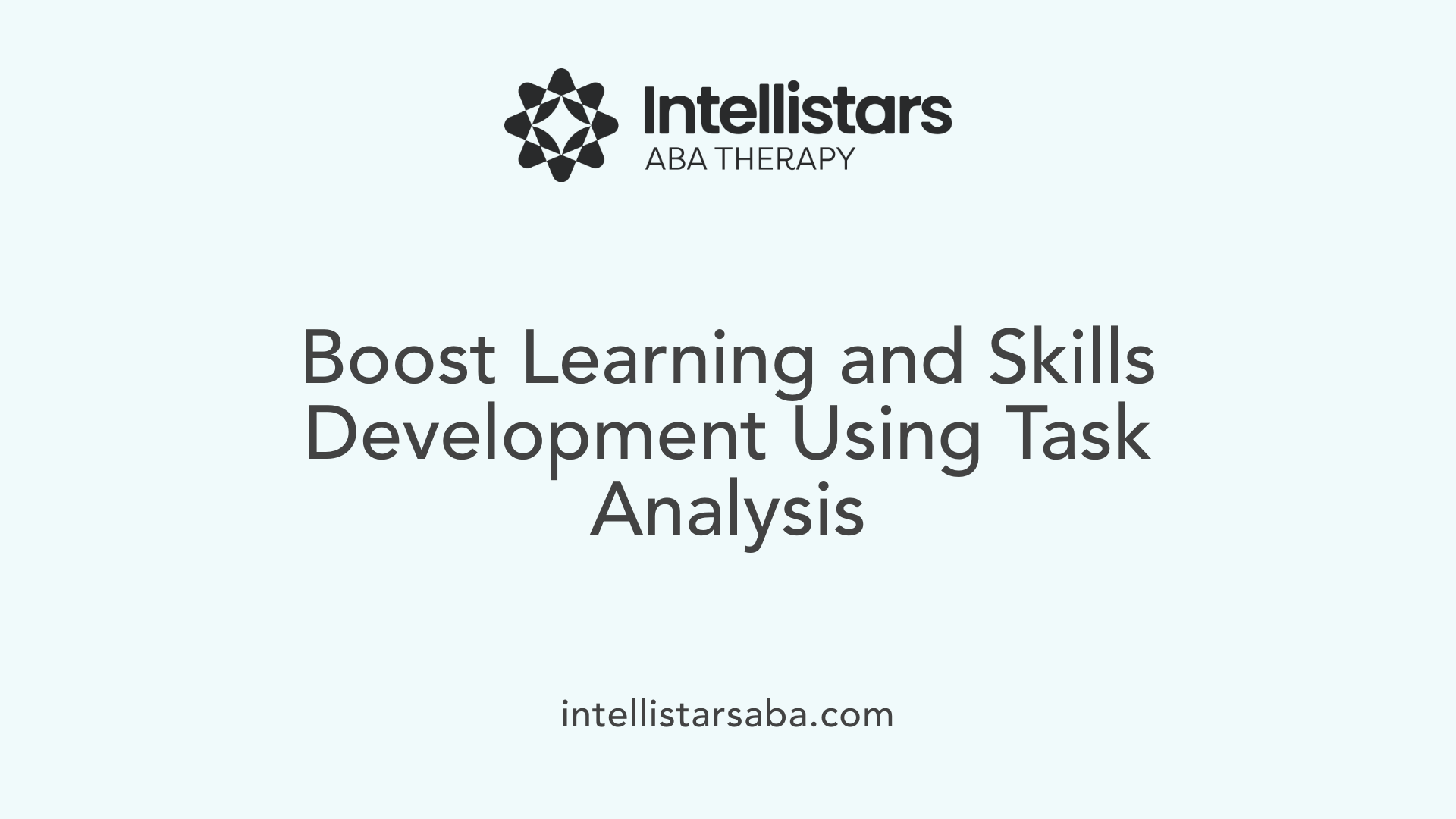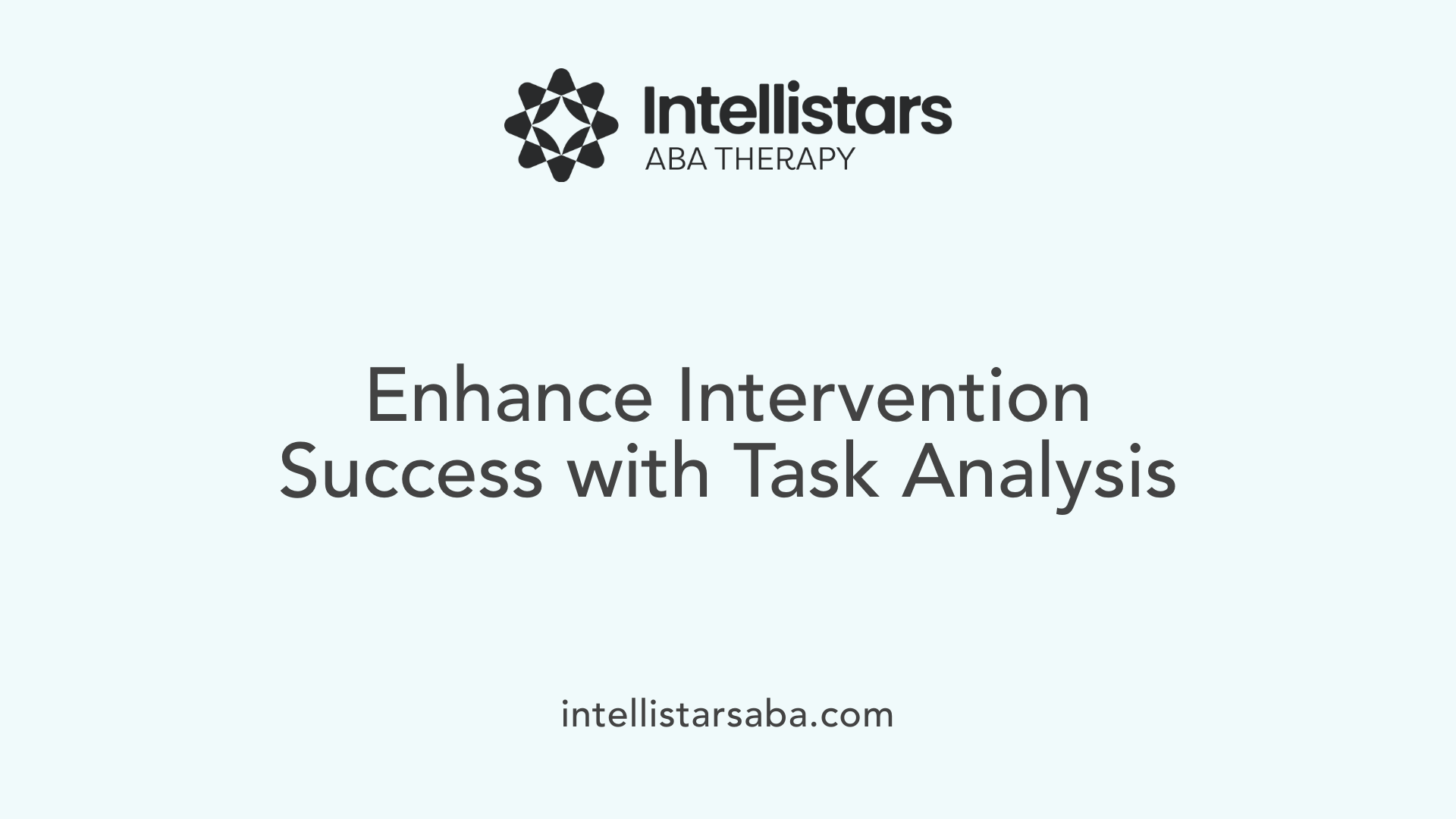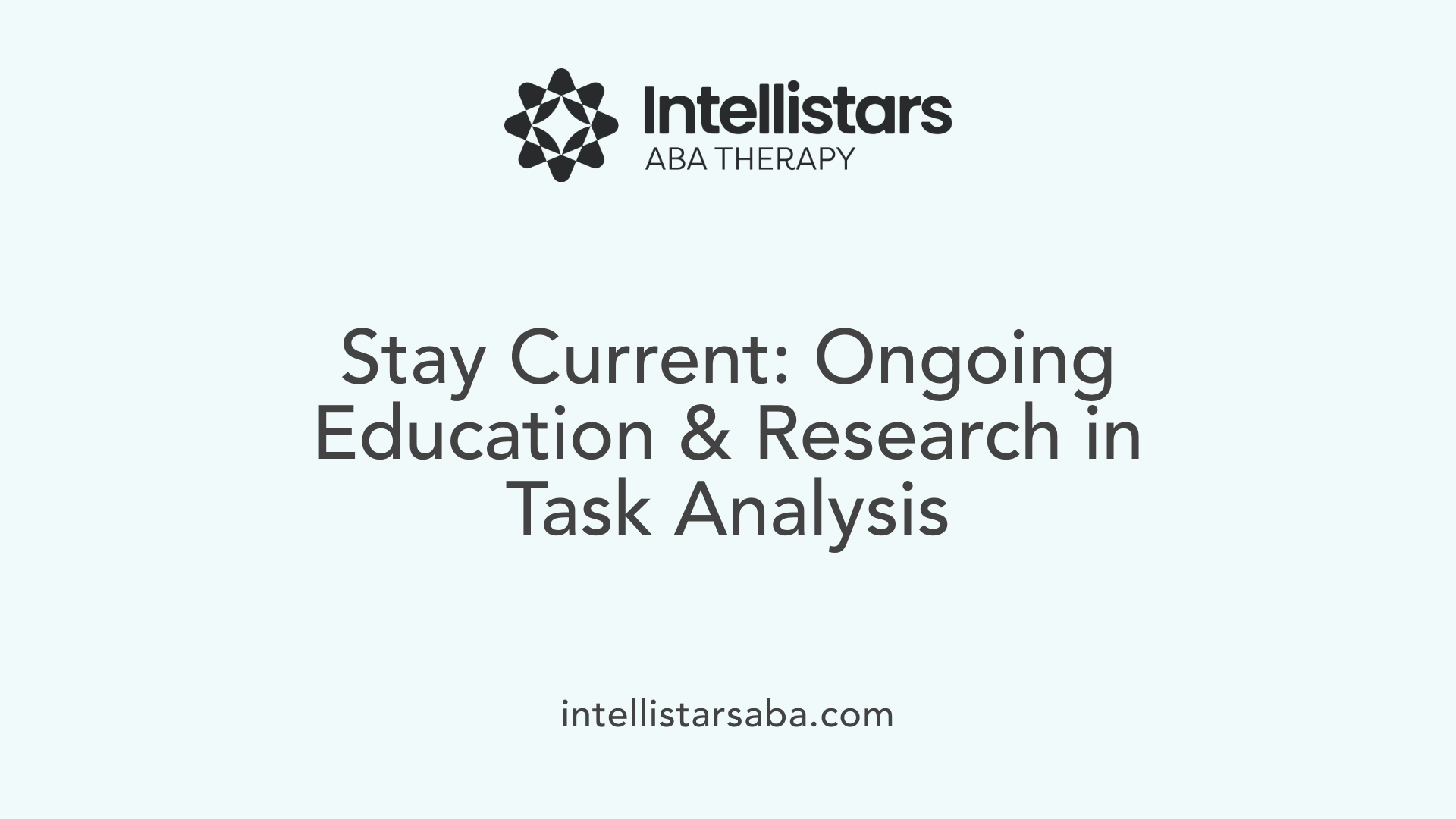Understanding the Foundations of Task Analysis in ABA Therapy
Task analysis is a cornerstone in applied behavior analysis (ABA) therapy, particularly when teaching complex skills to individuals with autism spectrum disorder (ASD). It involves dissecting multifaceted activities into smaller, manageable steps, thereby enabling tailored, systematic instruction that fosters independence and mastery. This article explores the significance, methodologies, and benefits of task analysis, illustrating its vital role in improving intervention effectiveness and learning outcomes.
The Significance of Task Analysis in Teaching Complex Skills
Why is task analysis important in ABA therapy?
Task analysis plays a crucial role in applied behavior analysis (ABA) therapy because it transforms complex, multi-step skills into manageable, sequential parts. This process is vital for individuals with autism spectrum disorder (ASD) as it makes learning more accessible and less overwhelming. By breaking down tasks like brushing teeth or tying shoelaces into smaller steps, therapists can teach each component systematically, ensuring better understanding and retention.
Task analysis is also adaptable, allowing clinicians to tailor approaches according to each person’s unique abilities, age, communication style, and previous experiences. This individualized approach increases the chances of success and helps reinforce skills effectively.
How does task analysis facilitate skill acquisition and retention?
Breaking skills into smaller steps simplifies learning, making it easier for individuals to grasp each part before progressing. Techniques such as forward chaining (teaching from the first step to the last), backward chaining (starting from the last step), and total task presentation (teaching all steps at once) are common methods used during task analysis.
Consistent practice with structured data collection ensures that each step is mastered before moving on. This method not only promotes immediate skill acquisition but also improves long-term retention by reinforcing proper execution through repetitive and clear instructions.
In what ways does task analysis promote independence and confidence?
As children and adults learn to complete tasks step-by-step, they develop a sense of accomplishment and autonomy. Achieving mastery in each step boosts confidence, encouraging learners to tackle new challenges with less reliance on assistance. Moreover, visual supports like checklists and charts enhance understanding, helping individuals remember steps and feel more competent.
This increased independence significantly improves quality of life, as individuals gain essential daily living skills such as making snacks, dressing, or communicating needs effectively.
How does task analysis improve task completion accuracy?
Providing clear, tailored instructions minimizes confusion and errors during task execution. Repeated practice combined with ongoing supervision helps ensure each step is performed correctly, promoting precision.
Monitoring progress through data collection allows therapists to identify where mistakes occur and adjust instructions accordingly. Over time, this leads to more accurate task completion and reduces the frustration and anxiety that often accompany mistakes or failed attempts.
What role does task analysis play in reducing frustration and anxiety?
Many learners with ASD find complex tasks overwhelming, which can cause frustration or anxiety. Task analysis mitigates this by simplifying tasks into small, manageable parts, making them less intimidating.
Individualized plans, visual supports, and consistent feedback contribute to a more predictable learning process, which helps children feel safe and motivated. Ultimately, breaking tasks into parts helps create a calm, structured learning environment that fosters positive experiences and ongoing motivation to learn.
Methods and Procedures in Conducting Task Analysis

What methods and procedures are involved in conducting task analysis in ABA therapy?
Conducting task analysis in ABA therapy involves systematically breaking down complex activities into small, manageable steps tailored to the individual’s skill level and needs. This process ensures that each part of a task is clear and teachable, paving the way for effective learning.
One common method used is forward chaining. With this approach, the individual is first taught to complete the initial step. Once mastered, the sequence is expanded to include the next step, gradually building the entire skill. Conversely, backward chaining starts with the last step of an activity, teaching it first, then working backward through the previous steps until the entire task can be performed independently.
Total task presentation is another technique where the entire activity is taught as a whole, with support and prompts provided as needed. This is ideal for skills that are less complex or when the learner has sufficient baseline skills.
In addition, therapists often use prompting, modeling, and visual supports such as schedules, cue cards, or checklists to aid understanding and independence. These supports can be physical, verbal, or visual cues that guide the learner through each step.
Observation and consultation are crucial during this process. Skilled professionals observe competent individuals performing tasks, consult with experts, and sometimes perform the task themselves. This collaborative approach helps refine steps and ensures the analysis reflects real-world application.
Data collection is integral to task analysis. Techniques such as frequency counts, task completion times, and mastery criteria help monitor the learner’s progress. Consistent data collection allows for the adjustment of strategies, ensuring learners achieve mastery before moving on to more complex activities.
Overall, employing these methods promotes structured, individualized instruction aimed at developing essential skills across daily living, communication, and social domains. The comprehensive approach enhances learning outcomes and supports greater independence.
Applying Task Analysis to Teach Complex Skills Effectively
How is task analysis applied to teach complex skills effectively in ABA therapy?
Task analysis is a foundational strategy in ABA therapy used to teach complex skills efficiently. It involves breaking down large, multifaceted activities into small, manageable steps. This process makes it easier for children with autism spectrum disorder (ASD) to understand and master the skills.
Therapists choose appropriate methods to deliver these steps based on the child's abilities. Common approaches include forward chaining, backward chaining, and total task presentation. Forward chaining starts with the first step, teaching it thoroughly before moving to the next. Backward chaining emphasizes the last step, encouraging completion from the end to the beginning. Total task presentation involves teaching the entire skill at once, with prompts as needed.
Reinforcement plays a vital role in this process. Positive feedback and rewards for successful completion motivate children and reinforce learning. Prompting techniques, such as physical guidance or visual cues, are used initially but gradually faded to foster independence.
Visual supports like charts, checklists, and pictorial guides significantly enhance understanding. These tools help children visualize each step, ensuring clarity and reducing frustration.
By systematically applying these strategies, practitioners can tailor interventions to each child’s individual needs. This approach not only accelerates skill acquisition but also builds confidence and independence.
Ultimately, effective application of task analysis leads to better educational outcomes and a broader range of functional skills—spanning daily living, social, and academic domains. It empowers children with ASD to navigate their environment more confidently and independently.
Benefits and Advantages of Using Task Analysis in ABA Interventions

What are the benefits and advantages of using task analysis in ABA-based interventions?
Task analysis provides multiple benefits in ABA therapy by breaking down complex skills into clear, manageable steps. This structured approach makes teaching more transparent and easier for learners to understand. When tasks are organized into smaller parts, individuals with autism can follow instructions step-by-step, which enhances their learning process.
One significant advantage of task analysis is its ability to promote personalized learning experiences. Therapists can identify which specific steps a learner struggles with and tailor teaching strategies accordingly. This customization increases the efficiency of skill acquisition, ensuring that each individual progresses at a suitable pace.
Using visual aids like charts and checklists alongside task analysis helps children grasp what needs to be done, reducing feelings of overwhelm. Visual supports make expectations clear, which boosts confidence and motivation, especially for children who interpret language literally or have processing challenges.
Task analysis also plays a crucial role in developing essential skills. It is widely used to teach daily living tasks (e.g., grooming, cooking), communication skills, and academic concepts. As learners master these steps, they become more independent, capable of functioning more effectively in their everyday lives.
Furthermore, by offering a systematic way to track progress through data collection, task analysis promotes consistency in teaching. Supervisors can monitor how well skills are acquired, make necessary adjustments, and confirm mastery before moving to the next step.
Overall, integrating task analysis into ABA interventions enhances learning outcomes, fosters skill generalization across various environments, and increases independence. It helps caregivers and professionals work collaboratively, ensuring that interventions are both effective and tailored to each learner’s unique needs.
Enhancing Learning Outcomes and Skill Development with Task Analysis

How does task analysis enhance learning outcomes and support skill development in ABA therapy?
Task analysis plays a vital role in improving how individuals with autism learn new skills and achieve greater independence. By systematically breaking down complex activities into smaller, manageable steps, it creates a clear pathway for learning. This approach allows practitioners to tailor teaching strategies to each individual’s needs, ensuring that instructions are understandable and achievable.
One of the main advantages of task analysis is that it reduces the cognitive load and anxiety often experienced by learners with ASD. When tasks are predictable and broken into sequential steps, learners feel more confident, which encourages active participation and persistence.
Practitioners employ various methods such as forward chaining, where they teach the first step and gradually add subsequent steps, or backward chaining, which starts from the last step and moves backwards. Total task presentation involves teaching the entire activity at once, tailored to the learner’s abilities. These techniques, along with reinforcement and visual supports like charts, checklists, and cues such as the "First, Then" strategy, help motivate learners and clarify expectations.
Monitoring progress through precise data collection—tracking task completion and behavioral responses—ensures that skills are mastered before progressing. This systematic approach accelerates skill acquisition and retention, translating into greater independence in daily life, communication, academic settings, and social interactions.
Overall, task analysis fosters a structured, predictable learning environment that systematically develops essential skills. This approach not only enhances educational outcomes but also boosts confidence and promotes lasting behavioral change, greatly improving the quality of life for individuals with autism.
Contribution of Task Analysis to Intervention Effectiveness for Complex Skills

How does task analysis support personalized and targeted approaches?
Task analysis plays a crucial role in customizing interventions for individuals with autism spectrum disorder (ASD). By breaking down complex behaviors—like self-care routines or communication tasks—into smaller, manageable steps, it allows educators and therapists to identify exactly where each learner needs support. This detailed approach ensures that teaching strategies are tailored to the individual's current skills, age, and processing abilities.
Different methods, such as forward chaining, backward chaining, or total task presentation, are chosen based on the learner's needs, helping to deliver instruction that is most effective. Visual tools like charts and checklists further assist in enhancing understanding and engagement, making learning more accessible. The customized nature of task analysis helps reduce frustration, enhances confidence, and promotes successful skill acquisition.
How does task analysis reduce frustration and increase chances of success?
Breaking skills into smaller parts makes tasks less overwhelming. When individuals with ASD encounter manageable steps, they are more likely to succeed rather than become frustrated or disengage. This structured approach increases their chances of completing tasks accurately, which boosts their confidence. Visual supports, such as checklists, serve as clear cues, guiding learners through each step.
Reducing errors and anxiety during learning sessions encourages positive experiences. Successful completion of steps fosters motivation and a sense of achievement, creating a positive cycle for ongoing learning.
How are assessment tools and strategies used to tailor interventions?
Assessment tools like the Adaptive Behavior Assessment System (ABAS) help gather comprehensive data about each learner's skills and difficulties. Behavior analysts and educators analyze this information to inform the development of precise task analyses tailored to individual needs.
They observe and perform tasks themselves, consult with experts, and incorporate trial-and-error methods to refine the steps. This thorough assessment process ensures that interventions are personalized, realistic, and aligned with the child's strengths and challenges.
How does progress monitoring and data collection improve intervention outcomes?
Tracking progress is fundamental to effective intervention. Data collection techniques such as frequency counts and task completion rates provide objective measures of how well each step is learned. Regular monitoring allows practitioners to identify which steps are mastered and which require additional focus.
Adjustments are made based on data, such as modifying steps or changing teaching strategies. This iterative process ensures continuous improvement, helping learners achieve mastery before progressing to more complex tasks. Consistent data collection also provides accountability and supports evidence-based decision-making.
How does involving caregivers and educators enhance the implementation of task analysis?
Caregivers and educators are vital partners in the success of task analysis. When they understand the breakdown of skills and how to support each step, they can practice skills at home and in other environments, reinforcing learning outside therapy sessions.
Training, collaboration, and open communication between professionals and families foster consistency and efficacy. Caregivers who are patient, communicate with therapists, and create opportunities for regular practice contribute significantly to generalizing skills across settings.
| Aspect | Description | How It Contributes |
|---|---|---|
| Individualization | Tailoring steps to the learner | Increases success and reduces frustration |
| Visual Supports | Checklists and charts | Enhances understanding and independence |
| Data Collection | Monitoring progress | Informs adjustments and measures mastery |
| Caregiver Role | Practice and support | Facilitates skill generalization |
Efficient implementation of task analysis through collaboration, assessment, and ongoing monitoring maximizes learning outcomes, promotes independence, and enriches the quality of life for individuals with ASD.
The Collaborative Role of Caregivers and Professionals in Task Analysis
How can caregivers and educators support the implementation of task analysis?
Caregivers and educators are vital to the success of task analysis, helping to reinforce skills learned during therapy sessions. They support this process by actively practicing skills with children at home and in other natural settings. Consistency is crucial; when children experience similar routines across different environments, they are more likely to generalize and retain new skills.
Patience and clear communication are essential. Caregivers should maintain open lines of dialogue with therapists and educators to understand the specific steps involved in each skill. Regular updates allow for adjustments to be made in teaching strategies and help prevent frustration.
Creating opportunities for structured practice is another important role. This can involve using visual supports such as charts, checklists, and prompts that guide children through tasks step-by-step. These tools make learning more manageable and increase the child's independence.
Training caregivers on prompts, reinforcement, and visual supports equips them with the skills needed to facilitate effective learning. When caregivers understand how to implement techniques consistently, they strengthen the child's ability to learn and perform skills outside of formal therapy.
Collaborative efforts among behavior analysts, teachers, and families also ensure that interventions are tailored to each child's unique needs. Monitoring progress together helps in making informed decisions and maintains motivation for everyone involved.
In summary, active involvement, patience, open communication, and shared training foster a supportive environment that promotes successful skill acquisition through task analysis, ultimately enhancing the child's independence and quality of life.
Ongoing Education and Research in Task Analysis

Why is ongoing education important for ABA professionals working with task analysis?
Continuing education plays a crucial role in the field of ABA, especially when it comes to task analysis. As research advances and new techniques emerge, staying informed ensures that practitioners can incorporate the latest evidence-based approaches into their interventions. This ongoing learning allows professionals to refine their methods, improve data collection, and adapt strategies to meet each individual's needs more effectively.
Professionals involved in task analysis benefit from continuous training by enhancing their skills in developing tailored interventions. Updated knowledge helps in designing more effective step breakdowns, selecting suitable teaching methods like forward or backward chaining, and creatively utilizing visual supports.
Moreover, ongoing education fosters a culture of excellence and innovation within the field. It encourages practitioners to evaluate and improve their practices, ensuring that individuals with autism receive the highest quality support. Staying current with research also helps in understanding how to better promote independence, enhance skill retention, and generalize skills across settings.
Ultimately, the goal of continuous learning is to improve outcomes for individuals with ASD by applying the most effective, up-to-date strategies in task analysis. It empowers caregivers, therapists, and educators to collaborate more confidently and effectively, leading to meaningful progress and greater independence for those they serve.
Benefits of continuous training for professionals
| Benefit | Explanation | Impact on Practice |
|---|---|---|
| Staying Updated | Keeps professionals informed about new methods and research | Improves intervention quality |
| Skill Enhancement | Develops and refines ABA techniques and strategies | Increases effectiveness of teaching |
| Better Data Analysis | Enhances ability to collect and interpret progress data | Informs necessary adjustments |
| Ethical and Practical Knowledge | Maintains adherence to the latest standards and ethical practices | Ensures responsible intervention |
| Professional Growth | Supports career development and confidence | Leads to improved service delivery |
Incorporating research findings into practice
Implementing new research into everyday practice involves ongoing training, reading recent studies, and participating in professional development sessions. When professionals learn about innovations—such as new ways to visualize steps or novel reinforcement strategies—they can adapt their task analyses accordingly.
Frequent review of research allows for the integration of best practices, making interventions more effective and personalized. Collaborative discussions, workshops, and supervision sessions are excellent opportunities to explore new findings and translate them into practical steps.
In summary, continuous education combined with research integration ensures that ABA professionals remain at the forefront of their field, providing the most effective interventions for individuals with autism. This commitment to learning ultimately leads to better skill acquisition, increased independence, and improved quality of life for the individuals served.
Maximizing the Impact of Task Analysis in ABA
Effective implementation of task analysis is crucial for advancing the teaching of complex skills within ABA therapy. By systematically breaking down activities, employing appropriate teaching methods, and tailoring interventions to individual needs, practitioners can significantly enhance learning outcomes. Collaboration with caregivers, ongoing professional development, and meticulous data tracking further bolster the success of these interventions. Ultimately, task analysis serves as a foundational tool that promotes independence, confidence, and functional skill mastery for individuals with autism, leading to improved quality of life and greater societal participation.
References
- What is Task Analysis in ABA Therapy?
- What Is Task Analysis in ABA Therapy, and How Does ...
- Task Analysis in ABA: an Overview
- 7 Ways Task Analysis is Used for RBT in ABA Therapy
- The Role of Task Analysis and Chaining: Articles: Indiana ...
- How task analysis benefits skill acquisition in ABA therapy
- Task Analysis in ABA Therapy: Strategies and Examples
- The Power of Task Analysis in ABA Therapy
- The Role of Task Analysis and Chaining: Articles: Indiana ...
- Task Analysis in ABA Therapy: Strategies and Examples






